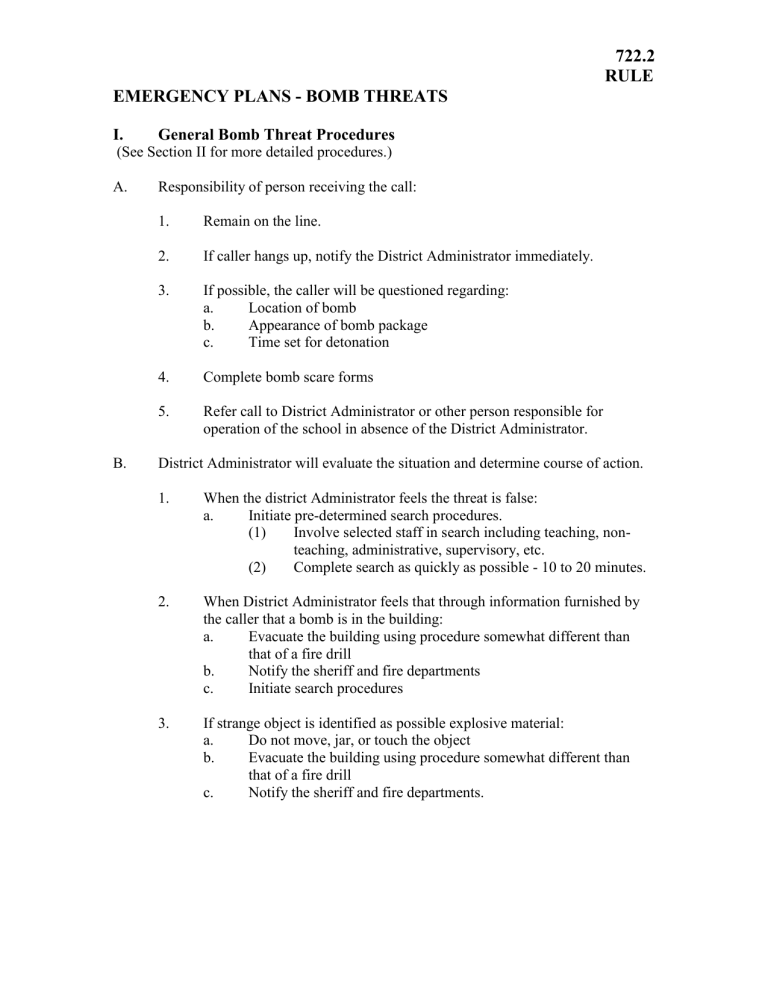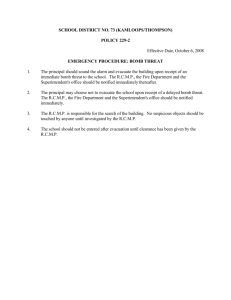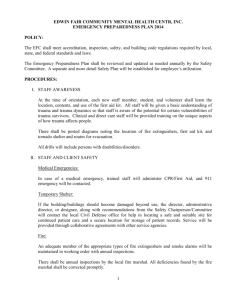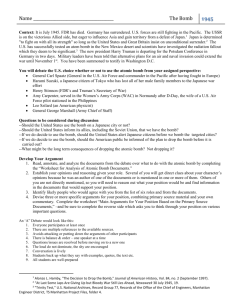Rule Emergency Plans - Bomb Threats

EMERGENCY PLANS - BOMB THREATS
722.2
RULE
I. General Bomb Threat Procedures
(See Section II for more detailed procedures.)
A. Responsibility of person receiving the call:
1. Remain on the line.
2.
3.
If caller hangs up, notify the District Administrator immediately.
If possible, the caller will be questioned regarding: a. b. c.
Location of bomb
Appearance of bomb package
Time set for detonation
4. Complete bomb scare forms
5. Refer call to District Administrator or other person responsible for operation of the school in absence of the District Administrator.
B. District Administrator will evaluate the situation and determine course of action.
When the district Administrator feels the threat is false: a. Initiate pre-determined search procedures.
1.
2.
(1) Involve selected staff in search including teaching, nonteaching, administrative, supervisory, etc.
(2) Complete search as quickly as possible - 10 to 20 minutes.
When District Administrator feels that through information furnished by the caller that a bomb is in the building: a. Evacuate the building using procedure somewhat different than that of a fire drill b. c.
Notify the sheriff and fire departments
Initiate search procedures
3. If strange object is identified as possible explosive material: a. b. c.
Do not move, jar, or touch the object
Evacuate the building using procedure somewhat different than that of a fire drill
Notify the sheriff and fire departments.
722.2 (2)
RULE
II. Detailed Bomb Threat Procedure
A telephone call to a school or elsewhere, stating that a bomb has been placed in the school, whereby the caller hangs up without giving detailed information, may be classified as a hoax, prank, or something done to harass school personnel, students or other public employees who may be dispatched to the school as a result of the call.
An individual actually having information regarding a bomb, who is communicating such information to a responsible school official, would be willing to give information and may answer questions concerning this information.
Instruct all personnel, especially those at the telephone switchboard, in what to do if a bomb threat call is received. As a minimum, every telephone operator or receptionist should be trained to respond calmly to a bomb threat call. To assist these individuals, a bomb threat call checklist (Exhibit A) should be kept nearby.
If possible, it is desirable that more than one person listens in on the call. A calm response to the bomb threat could result in getting additional information. This is especially true if the caller wishes to avoid injuries or deaths. If told that the building is occupied or cannot be evacuated in time, the bomber may be willing to give more specific information on the bomb's location.
A. Upon receipt of a telephone call by school personnel, wherein the caller reports that there is a bomb in the building, the following procedure is to be employed:
1. The person receiving such a call shall inform the caller; "I'll connect you with the District Administrator" (or designee if the District Administrator is not present). The person connecting the call should also continue to listen in (if possible).
2. Locate "Bomb Scare Form" and try to determine as much information on it.
3. Whenever possible, the District Administrator/designee will question the caller and attempt to determine: a. The location of the bomb b. c. d. e.
The appearance of bomb package
The time set for detonation
The type of explosive material
Any other pertinent information
Keep the caller on the line as long as possible. Ask the individual to repeat the message. Record every word spoken by the person. Listen closely.
722.2 (3)
RULE
4. If the caller refuses to talk to the District Administrator or merely calls and hangs up, the person receiving the call shall immediately notify the
District Administrator and share all information regarding the call.
The person who receives the call should also complete a bomb scare form that includes a description of the caller's voice.
B. The District Administrator will evaluate the information received and decide on one of the two following courses of action:
1. Possible False Bomb Threat Procedure: a. Have the head custodian and all non-teaching staff report to the office at once for instructions.
(1) The head custodian shall be instructed to use his subordinates to conduct a search of the building without disrupting classes in session. Detailed instructions to the custodian (Exhibit B) should be reviewed in advance, to conserve time when the threat occurs.
Public access areas (boiler rooms, and outside areas adjacent to the building) should be given priority. For this reason, litter cans and other things, which could harbor explosives, should be kept away from the building.
(2) All other non-teaching personnel shall be assigned familiar areas to search.
(3) By a prearranged signal, all teachers are to scan their rooms. This does not require a detailed search. Classes should not be disrupted or dismissed. b. All school personnel assigned to searching are to report their findings to the District Administrator within twenty minutes after receiving such detail. Assign search areas to knowledgeable people and limit the area to a twenty-minute capability.
2.
722.2 (4)
RULE c. d.
When it is determined that no bomb is evident, resume normal routine. All false bomb threats must be reported to the Washington
County Sheriff's Department.
When an object is discovered that appears to be a bomb or explosive, follow procedures under "Discovery of Suspicious
Object Procedure."
Possible Real Bomb in Building Procedure:
In any instance of where the District Administrator feels the “reported bomb in building:” is valid due to the willingness of the informer to give detailed convincing information, the District Administrator shall proceed as outlined below.
Evacuation of the Building a. If evacuation of the school building is deemed necessary, the signal for evacuating the building in the event of a bomb threat should not be the same as that for a fire. In the bomb threat, where possible, all doors and windows should be opened to permit the blast wave to escape in the event of an explosion. Also, evacuation routes will have to be determined if a bomb is found so as to lead people away from the bomb. b.
(1) The County Sheriff's Office should be notified (911). This additional manpower will shorten the search.
An organized and trained evacuation unit consisting of key personnel should follow pre-designated plan of evacuation.
Priority of evacuation should be considered. c. d.
If the building is evacuated, controls must be established immediately to prevent unauthorized access to the building. These controls may have to be provided by key personnel until fire and police arrive to prevent re-entry into the building until the danger has passed.
Evacuate persons to a safe distance away from the building to protect them against debris and other flying objects if there is an explosion. The following should be done if the situation
722.2 (5)
RULE warrants: If the building is evacuated, all gas and fuel lines should be cut off at the main valve. All electrical equipment should be turned off prior to evacuation. The decision to cut off all electrical power at the main switch should be made by the District
Administrator/designee with consideration given to lighting requirements for search teams. e. During the search, the emergency trained personnel of the building should be alerted to stand by in case of an accident caused by an explosion of the device. f Pre-emergency plans should include a temporary relocation in the event the bomb threat materializes and the building is determined to be unsafe.
Room Search g School personnel (teachers, administrators, counselors, custodians, and other school employees) may be used to search areas familiar to them. People make the best and quickest search familiar with normal objects and conditions in their work areas. See Exhibit B. h. When it is determined that no bomb is evident, resume normal routine. All bomb threats must be reported to the Washington
County Sheriff's Department. i. When an object is discovered that appears to be a bomb or explosive, follow procedures under "Discovery of Suspicious
Object Procedure."
C. Discovery of Suspicious Object Procedure
1. Strange objects that could possibly be bombs are not to be moved. If located in a classroom or other occupied area, this room/area and rooms or areas immediately adjacent to it are to be evacuated at once, if evacuation has not already occurred, until someone in authority can examine and rule on the object. These rooms/areas may be reoccupied as soon as the object is declared safe, or after it has been removed to a safe location.
722.2 (6)
RULE
2. If the object is positively identified as an explosive object, the entire school should be evacuated, if evacuation has not already occurred, following bomb threat drill instructions and procedures.
3.
4.
Whenever an object is found which could be an explosive device, the
Washington County Sheriff's Department should be notified immediately by dialing 911.
Suspected objects should be left to specialized persons to evaluate, handle, and process. The school employees' responsibility ends when the search produces a suspect object. Employees should report their findings and move to a safe distance.
5.
D. Additional things to be considered in handling bombs and bomb threats.
1. Try to eliminate publicity and discussion, so as to avoid spreading the idea to others.
2.
A report should be made to the District Administrator/designee.
The entire chain of command, from the District Administrator to the last employee, should be informed of these plans.
(a) Teachers and all other employees should be briefed on their part of the procedure, so they will respond calmly when a threat develops.
(b) This should be considered part of their duties, and entered into employee contracts.
3. All procedures should be treated confidentially. Do not post on employee bulletin boards. Plans should be kept in a folder accessible to those who should be familiar with them.
4. All packages received by mail should be inspected thoroughly before being sent to storage.
E. Conclusion
Historically, school bomb threats appear to have been committed by persons who wish to harass school administrators, police and fire personnel, or create a disruption in the school day. Since such calls are likely to be made by a prankster, evacuating in every instance may encourage such pranksters to repeat these nuisance calls, the same as false alarms to the fire department are repeated and may increase when instant response is forthcoming each time they make such a call.
722.2 (7)
RULE
School bombings are usually directed against non-student areas. Find out which teachers or staff members are unpopular and where they work. The problem areas in schools are student lockers and the science room. If lockers seem to "tick" which may be due to alarm clocks, watches, leaking thermos jugs, etc., school authorities or police should consider cutting off the locks; then search teams could open the lockers. However, the school may be responsible for paying for a lock if destroyed in this manner.
Science room should be treated with caution. A student may try to make an explosive mixture in the classroom, get scared, and phone in a bomb call. The best procedure is to have the science teacher inspect the classroom lab and chemical storage area with you.
The teacher will know 90% of the items in the lab that leaves only 10% to worry about.
If repeated bomb threats are received at schools in your area, recommend that the school board hold make-up classes on Saturday. This tends to cut down the number of bomb scares.
Each bomb threat call must be evaluated and an appropriate response determined by the person in charge of each school.
Approved: November 25, 2002
FRIESS LAKE SCHOOL DISTRICT
Hubertus, Wisconsin








